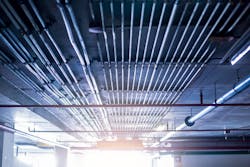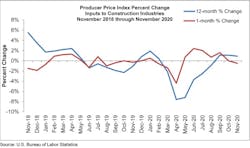The State of Material Shortages and the Electrical Industry
Economic disruptions often carry consequences for availability and prices of raw materials, and that looks to be the case in the construction sector as a year like no other winds down.
The U.S. Chamber of Commerce Q4 2020 Commercial Construction Index (CCI) shows contractor concern about building product and material shortages spiking in the fourth quarter. The share of contractors polled saying they are facing shortages of at least one material stands at 71%, up from 54% in Q3. And more say they’re worried about the consequences of shortages; 74% say they’ll have a moderate to high impact on their business, up from 63% in Q3 and two points higher than a year ago.
This year’s index has surely been colored by the pandemic, which throttled a lot of construction activity initially and continued to breed uncertainty as it surged and receded through the year. Predictably, that has produced ripple effects on building material supply chains that are seemingly still coursing through the system. Many contractors say the pandemic bears a lot of the blame for challenges in securing building products and materials; 41% says that’s been a severe byproduct.
Wood/lumber has been the most volatile material thanks to a housing construction boom, and it tops the CCI list with most mentions for short supply at 31%. But materials used by electrical contractors ranked right below it – 11% said electrical products other than copper wire were in short supply and 10% mentioned lighting products.
Contractors might have cause for worry about materials pricing heading into 2021. Gordian, which recently released its RSMeans 2021 construction costs database, says 90% of material, equipment and labor costs changed during the year, with 57% of construction materials increasing in price. The database includes a short video presentation highlighting some of the areas of cost spikes. Some examples: construction-grade lumber is up 56%; copper, 26%; copper cable and conductors, 20%; EMT conduit, 2.3%; panelboards, 1%. Electrical Marketing’s Electrical Price Index for November shows aggregate prices on about 30 electrical products up about 2% in 2020.
“Our electrical engineering expert says the major problem this year has been not shortages, but instead, price changes,” says Bob Mewis, principal engineer with Gordian.
Gordian calls the fluctuation in construction costs in 2020 “unusual,” and says, “it’s clear construction will cost more in 2021.”
Another view comes from Associated Builders and Contractors. Its most recent data from November show construction input costs plummeted from January through April, quickly rebounded through late August before flattening but ended November just .9% higher than a year earlier (see Chart below). But chief economist Anirban Basu cautions that an end to the pandemic could set the stage for a cost surge as building activity resumes en masse. There’s a possibility of “rapidly rising input prices at some point next year.”
But the pandemic may leave a lasting impact on construction costs beyond materials. New job-site protocols for keeping viruses at bay are sure to add to construction costs, enough so that the RSMeans 2021 cost database incorporates specific related line-item costs and modifiers. They’re significant enough, says chief product officer Noam Reininger, that “anyone estimating the cost of construction work in 2021 is affected by significant cost changes.”
Zind is a freelance writer based in Lees Summit, Mo. He can be reached at [email protected].
About the Author
Tom Zind
Freelance Writer
Zind is a freelance writer based in Lee’s Summit, Mo. He can be reached at [email protected].

